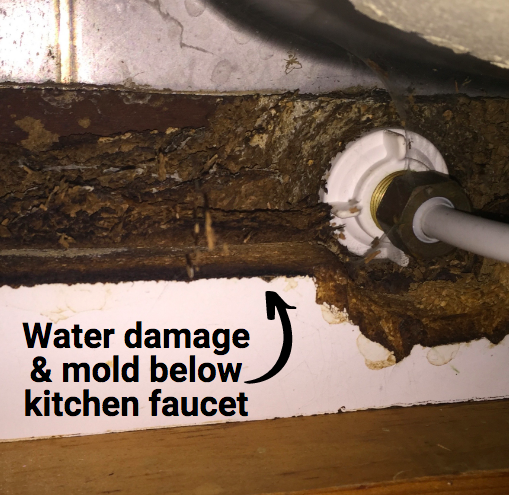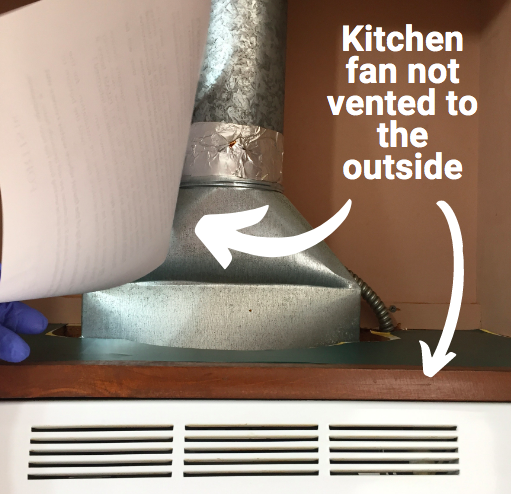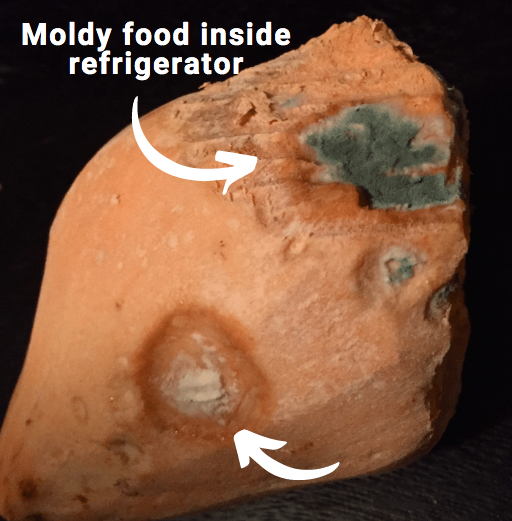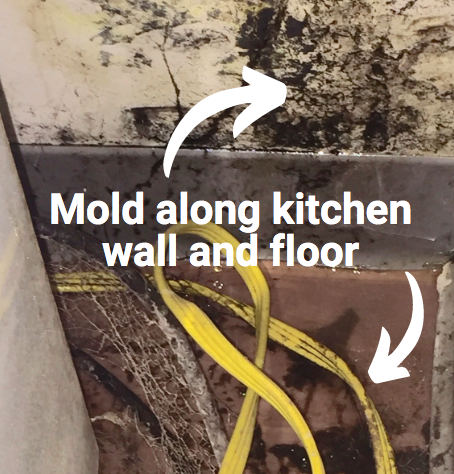Shopping cart
Recent Posts
Newsletter
Sign Up to get updates & news about us .
- 604 729 4261
- info@moldinsight.com
- Work Time: Mon - Sat 8AM - 6PM, Sun 9AM - 5PM
Sign Up to get updates & news about us .

Do you see or smell signs of mold in your kitchen that concern you? If so, you share the same concerns with millions of others out there, so read on to learn more.
This chapter is all about why a kitchen is commonplace for mold to grow, how to deal with it, and the best way to prevent it from coming back.
The kitchen is much like the laundry room and bathrooms. A lot of extra moisture is generated there.
Top mounted sinks can be problematic. Unsealed seams and the area directly behind the faucets are where a lot of moisture accumulates, along with the backsplash.
It is not uncommon to find water damage and mold on the particleboard directly below the kitchen sink, as noted in the picture.
Continuous moisture allows mold to grow quickly, so take a look to see if any mold growth is present.
Refrigerator and dishwasher leaks have been known to cause moisture and mold damage because of loose connections or faulty mechanisms.
Poor ventilation while cooking contributes to high indoor humidity that can result in mold growth on flat surfaces, such as walls, ceilings, floors, and countertops.
This picture is a perfect example of incorrect ventilation that contributes to this issue.


Other not so obvious sources of kitchen mold include the garbage, compost bins, and disposal units (garburators)
Composting is one of the worst contributors to mold in the kitchen because of the amount of wet, organic rotting food that we accumulate. Yuck!
If you have a garbage disposal unit, or what many refer to as a garburator, mold can and does grow there as well.
A story from the front lines… Disgusting mold growing inside the garburator!
Here’s the scoop: The owners of a condo were renting out the unit to college students. In their ultimate wisdom, the students decided to fill up the disposer with an abundance of random, discarded food.
As it turned out the garbage disposal (garburator) was not working. Hmm…
Meanwhile, the students moved out and decided not to clean the food out, or fix the unit. So, the damp decaying food had been sitting there for quite some time.
When I arrived, I noticed the moldy, rotten food smell, and it was repulsive! I didn’t eat lunch that day…
The sale of the condo was subject to the removal of the disposer, and an air quality test to prove that the mold spore counts in the condo would be safe again before the sale could move forward.
Just one of many mold situations I come across as a mold inspector.


At one time or another, we have all noticed the evidence… that green fuzzy mold growing under the lid of aunt Becky’s leftover spaghetti from a few months ago. I think you can all relate.
There will always be condensation and bacteria inside the refrigerator, which is why you will see mold there.
Did you know that many foods are prone to mold growth when you refrigerate them?
Another source of mold comes from dishwasher and refrigerator leaks. Often these leaks occur when people are not at home, unfortunately.
Unless immediate action is taken to stop the leak and dry the floor, you can expect mold to grow below the surface. Organic materials with wood and laminate are prone to mold contamination.
A moisture meter can be used to find out if the surface directly below the floor is wet. If so, there is likely a mold issue.
Kitchen mold accumulates on a lower wall behind the refrigerator, inside cabinets, ceilings, behind the stove and or refrigerator. Essentially, anywhere there is enough organic material, high humidity, and standing water, mold will grow.
The approach you take for your mold removal strategy depends on the severity of the problem, and if there is water damage or surface mold.
You can easily clean minor surface mold from a wall, or under the kitchen sink if it is found quickly. On porous surfaces, you need to address the mold as soon as possible or it will grow into the item(s).
Air quality testing may also be a part of the strategy, especially when a leak or flood was not contained in time. There are times when there is a strong musty odour, yet the mold cannot be seen.
More often than not, the mold is present within the floor, inside, or below the kitchen cabinets.
If this is the case and the air quality test registers high mold spore readings, then a remediation contractor will need to be called in to investigate and remove the mold.
Frequently check under the kitchen sink, along the floor by the refrigerator and dishwasher for leaks.
You don’t want to discover a longstanding leak like the one in the photo.

Mold grows below the floor surface because water seeps down through what is known as “capillary action”.
Unfortunately, there is no way to dry out the floor from below. In this case, the only way to prevent a mold problem is to remove the floor within a maximum time of 48 hours. This can be expensive.
Never install carpet in the kitchen. It will only absorb moisture and organic debris that is conducive to mold growth.
Although many people love hardwood or laminate, I would recommend high-end vinyl flooring or tile. Several types look great and cost much less than wood.
If you want laminate, there are newer moisture-resistant types. They will be more expensive than regular laminate flooring.
Next, always try to be at home when you run the dishwasher to catch any leaks quickly.
Use the exhaust fan while cooking and make sure that it is properly connected to a rigid metal duct and vented to the outside. This will help prevent excess humidity from accumulating along the walls, ceiling, and windows.
When the weather is dry, open the windows for an exchange of fresh air.
If you live in a humid environment like Florida, consider purchasing a dehumidifier. You want to keep the indoor humidity less than 50%.
Buy water leak alarms for areas close to dishwashers & refrigerators. Consider placing them under the kitchen sink by the pipes.
Don’t restrict yourself to the kitchen only. Water alarms can be placed anywhere in your home where there is a possibility of a leak, including the water heater, the washing machine, under the bathroom under any sinks, and by toilets.
You can buy one at your local hardware store or online.
Use a small compost bin with a sealed lid. Remove compost often so the mold-producing waste does not have too much time to accumulate. (There is a good reason why kitchen compost bins are small)
Clean all mildew and caulk the seams along the sink to prevent mold and water damage. This is especially important for top-mounted sinks.
Buy a mold/mildew-resistant caulk from your local hardware store. There are several types to choose from, so ask for a silicone caulk specifically for kitchens.
Frequently clean the walls and inside cabinets. Pull out your refrigerator and stove so you can clean thoroughly every month or so.
Prevent mold and protect the surfaces of your cupboard drawers and the base below your kitchen sink with waterproof shelf liners.
They too can be found at your local supermarket, hardware store, and online.
Check out the photo and don’t let this happen!

If you are remodeling your kitchen, consider applying mold-resistant paint. There are several types on the market to choose from. Visit your local paint and or hardware store for options.
You can reduce the humidity from your kitchen if the hood fan is properly installed and vented to the outside, rather than back into the kitchen.
Often these fans discharge the warm humid air directly into the attic, so if you are unsure, take a look or call a ventilation contractor to find out.
If you were thinking about installing a disposer, I would recommend against it as they are problematic and require frequent maintenance. They are designed to give plumbers a steady paycheck, but shhh, I didn’t tell you this.
Garbage Disposers (garburators) can contribute to mold and unpleasant odors, as we learned from my case study above…
Here are some excellent maintenance tips for you:
The next and last chapter is all about laundry room mold, so if you haven’t done so, check it out to discover all the answers you are looking for…